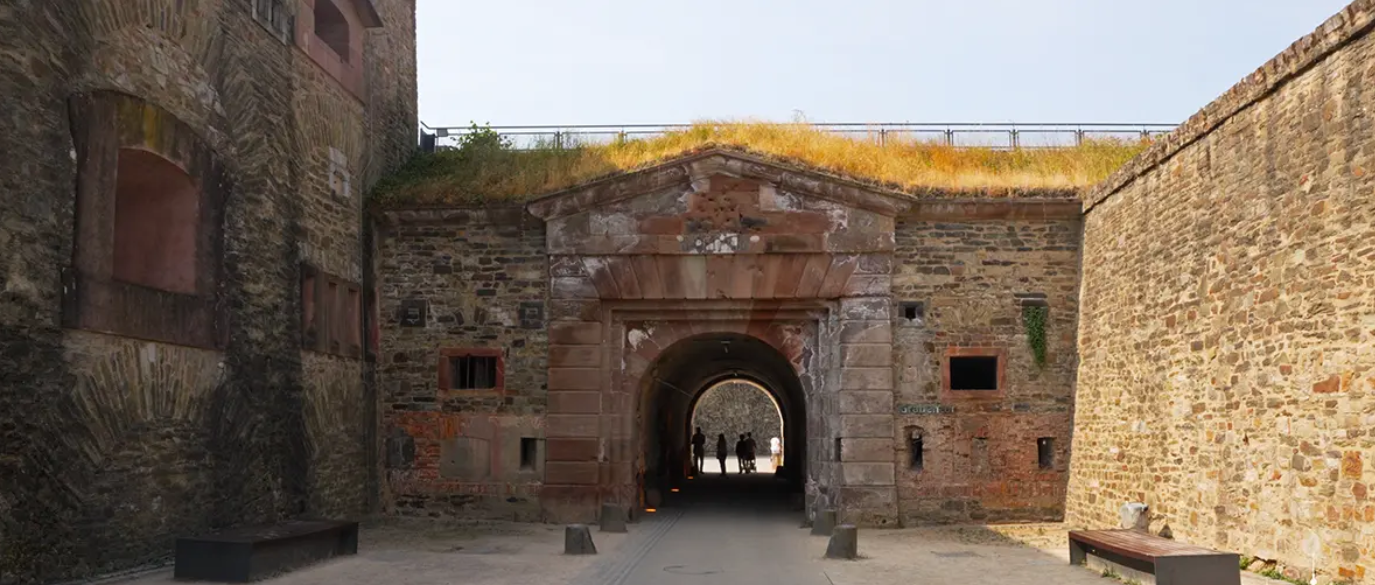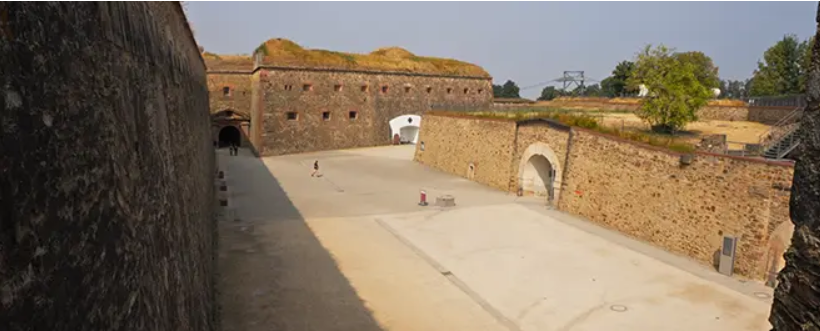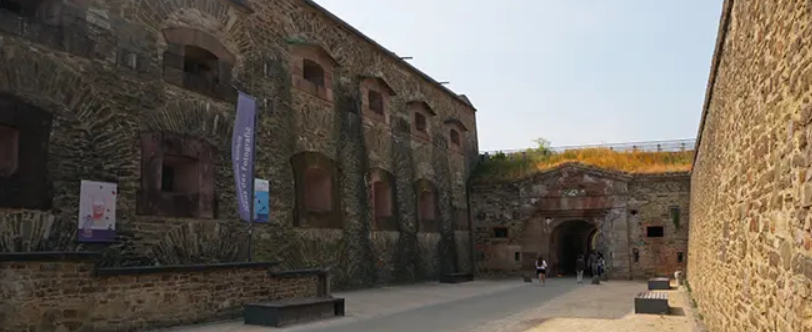The fortress has risen majestically above Koblenz since the 16th century.
Address: Ehrenbreitstein Fortress, Greifenklaustraße, 56077 Koblenz | Rebuilt: 1817 to 1828
One of the most famous sights in Koblenz is the famous Ehrenbreitstein Fortress, perched on a rock on the banks of the Rhine opposite the mouth of the Moselle. Settlements and fortifications existed on this mighty hill as early as 3,000 years ago, as recent excavations confirm. Celts and Germanic tribes had already settled on this hill. The Rhine could also be crossed via a Roman bridge as early as 49 AD.
The historic building exudes a magical air and possesses a special attraction, just as the fortress perched atop the rocky outcrop. From the Ehrenbreitstein Fortress, visitors are treated to a unique view of the spot where the Moselle River flows into the Rhine and the city of Koblenz. While the Prussian building formerly served as a defensive structure and barracks, the Ehrenbreitstein Fortress is now a lively cultural center with exciting exhibitions and a broad cultural program as well as colorful offerings for young and old.
Directions and Location of Koblenz’s Landmark
Perched on a mighty hill at a height of 118 meters, Ehrenbreitstein Fortress towers above the banks of the Rhine, at the point where the Moselle River flows into the Rhine. This impressive Prussian fortress can be seen from afar. Those wishing to visit the historic building can take the Koblenz cable car up to the plateau. You can also take the Felsenweg (Rock Path) up to Ehrenbreitstein Fortress. However, to reach the landmark directly, you must take the fortress elevator, as there is no other way to access the site. This demonstrates that a sophisticated security concept was pursued during the construction of Ehrenbreitstein Fortress.
Opening Hours and Tours
Ehrenbreitstein Fortress is generally open to visitors daily, allowing them to explore the structure on their own and enjoy the unique view. During events, however, opening hours vary depending on the specific event. Ehrenbreitstein Fortress can generally be visited during the following times, although free access to the grounds and restaurants is slightly different.
Ehrenbreitstein Fortress Opening Hours
Building Opening Hours
Monday to Sunday – from 10:00 a.m. to 4:00 p.m. or 6:00 p.m.
• Free access to the grounds and restaurants
from 10:00 a.m. to midnight
The fortress is closed on Christmas Eve and New Year’s Eve.

Admission Prices
Tickets for a tour of Ehrenbreitstein Fortress are available at various prices. The admission price includes all museums and exhibitions located within the fortress. This allows for a reasonable price to see and admire many things. Afterwards, the fortress’s outdoor area is generally free to visit, unless events are taking place. Special regulations apply for these.
Admission Prices Ehrenbreitstein Fortress
Single Adult Ticket
€8.00
Single Child/Youth Ticket (7-17 years and concessions)
€4.00
Schoolchildren, Students, and Apprentices
€5.00
Adult Concession
€7.00
Family Ticket 1 (1 adult and up to 4 children)
€9.50
Family Ticket 2 (2 adults and up to 4 children)
€16.50
Admission is free for children under 7 years of age. Concessions are also available for those receiving citizen’s income upon presentation of appropriate proof. Pensioners and severely disabled people also receive reduced admission prices.
FAQ – Frequently Asked Questions about Ehrenbreitstein Fortress
When was Ehrenbreitstein Fortress built?
The current fortress was built between 1817 and 1828 during the reign of King Frederick William III of Prussia. It was built as part of the Prussian fortifications on the Ehrenbreitstein Hill above Koblenz.
Ehrenbreitstein Fortress – Special Features and Interesting Facts
Ehrenbreitstein Fortress is an integral part of Koblenz Fortress, which encompassed a total circumference of 14 kilometers. Ehrenbreitstein was the main bastion, which, after its expansion during the Prussian period, was one of the largest fortifications in all of Europe.
Strategically, Ehrenbreitstein Fortress never achieved the importance of other fortifications, such as the Fortress of Gibraltar or the Fortress of Luxembourg. However, when completed, the Koblenz Fortress was considered impregnable because it was already designed with the types of attacks and weapons commonly used at the time in mind. The size of the fortress is attributed to the range of the firearms commonly used at the time.
Should war break out, 80 guns and 1,500 soldiers could conduct the defense of Ehrenbreitstein and Koblenz from there. The fortress was prepared for defense eight times in total, but it never suffered an attack. During the First World War, however, eight air raids were carried out on Ehrenbreitstein Fortress starting in October 1917.
Only professional soldiers and conscripts were stationed there, and they were actually very comfortably accommodated after the military reform of 1808. The entire fortress remained in active use until 1890. From 1890 onward, Ehrenbreitstein’s defensive role was no longer as important as it had been in earlier times, leading to its decline in importance.
Today, Ehrenbreitstein Fortress is not only a popular tourist destination, but also a venue for unique events. It now belongs to the state of Rhineland-Palatinate. The buildings now house the Koblenz State Museum, several administrative offices, the German Army Memorial, and a youth hostel.
Exciting tours are offered for everyone, with even children enjoying themselves. Various tours include, among other things, stories about the lives of the soldiers of the Prussian army at the time. In good weather, a unique view can be enjoyed from the fortress plateau. The view extends far into the Eifel, the Hunsrück and the Westerwald.

Historical Facts and History of Ehrenbreitstein Fortress
A predecessor building stood on the site of the former Ehrenbreitstein Fortress as early as the year 1000. Towards the end of the 10th century, Erembert, a member of the Conradine dynasty, had a fortress built on the rock. The rock was presumably named after him. The strategic importance of this fortress was not lost on the Archbishops of Trier, which is why Archbishop Hillin further expanded the fortress and reinforced it on the southern side of the rock. Helfenstein Castle was built for this purpose.
In 1483, Archbishop John of Baden had a well built 56 meters deep. The fortress was expanded into a fortified bastion by Richard von Greiffenclau. During the Thirty Years’ War, the French occupied the fortress. However, the siege did not last very long and ended after a year. During these turbulent times, the historic walls served as a safe depository for the Holy Robe and the electoral archives.
The Ehrenbreitstein Fortress was repeatedly rebuilt and expanded. As a result, it was considered impregnable over the centuries. Warfare always took place at the foot of the fortress. The French revolutionary troops were the first to succeed in starving the garrison of Ehrenbreitstein Fortress out of existence.
In 1801, after the Peace of Lunéville, the French were forced to abandon the right bank of the Rhine and perceived the German fortress on the rocky plateau as a threat. This led to the fortifications being blown up. The fortress was refortified during the Prussian period. The work was completed in 1832. During the Franco-Prussian War and the First World War, the fortress was repeatedly the scene of war.
The Treaty of Versailles stipulated that all fortifications within a 50-kilometer radius on the right bank of the Rhine were to be demolished. Ehrenbreitstein was considered less important from a military perspective. As a result, it was spared from destruction.
In 1819, the Americans, as victorious powers, hoisted the American flag over Ehrenbreitstein Fortress. The Star-Spangled Banner flew again over the fortress in 1945. During World War II, the fortress, which suffered little damage, served as a shelter for the people of Koblenz whose homes had been bombed out. In 1970, Ehrenbreitstein Fortress became the property of the Rhineland-Palatinate State Office for the Preservation of Historical Monuments.

Sights and attractions in the immediate vicinity of Ehrenbreitstein Fortress
Ehrenbreitstein Fortress itself offers a wealth of sights and attractions, allowing you to explore and immerse yourself deeply in its history.
In the fortress park, there is a special work of art that isn’t immediately apparent at first glance. In the middle of the green spaces is the so-called slate spiral. This realistic work of art, correctly titled “Moselle Rhine Whirlpool,” addresses themes of growth and decay, or biomorphic and organic. Created from slate by British artist Chris Drury, the work is broadly reminiscent of a whirlpool. The artist dedicates his works to the interplay of culture and nature.
If you look around a bit, you can discover other sculptures placed on the plateau by the path. There are four stone monuments designated “Artists Against Violence.” The concept behind these sculptures revolves around the significant role violence plays in everyday life and in the media. People are constantly exposed to violence in various forms, for example, through child abuse, physical assault, or war. The artists Uta Schade, Clemens M. Strugalla, Stefan Voigtländer, and Otto Lohrengel take a clear stance on the topic of everyday violence, which is entirely preventable.
It is worth exploring Ehrenbreitstein Fortress more closely and paying attention to the special details, some of which are not immediately obvious, in order to immerse yourself in the history, heritage, and unique features of this fortress.
Cafés and Restaurants Near Ehrenbreitstein Fortress
Restaurants located both in the immediate vicinity and a short distance from Ehrenbreitstein Fortress cater to your culinary needs. Guests can look forward to a wide selection of food and drinks served in a cozy, inviting atmosphere.
Restaurant Casino
Ehrenbreitstein Fortress features the Casino Restaurant, located on the fortress plateau. In fine weather, meals can be enjoyed on the large outdoor terrace with spectacular views. The kitchen serves German, European, and Central European dishes, ensuring there’s something for every taste.
Address: Restaurant Casino, Ehrenbreitstein Fortress 1
Restaurant Maharani
The Maharani Obertal is an Indian restaurant that introduces its guests to the specialties of Indian cuisine. Guests can choose between chicken tikka masala, palak paneer, fried vegetables, cauliflower curry with various spices, or naan bread. Delicious dishes can be enjoyed in a pleasant atmosphere.
Address: Restaurant Maharani, Obertal